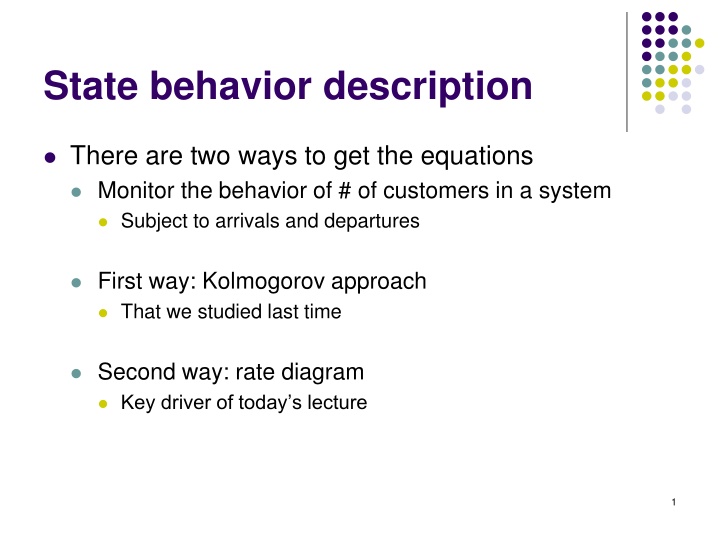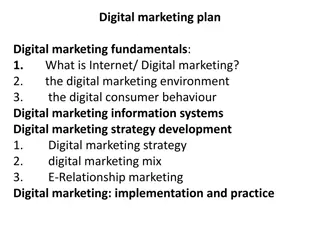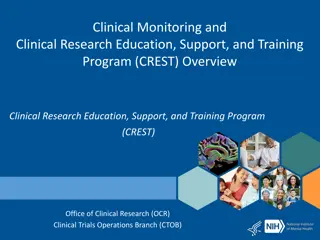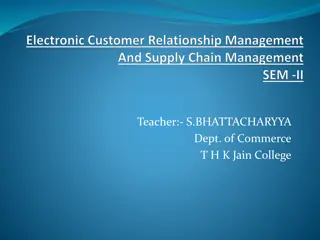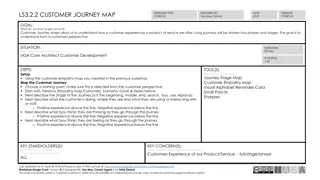Monitoring Customer Behavior in Systems
Two ways to analyze the behavior of customers in a system: the Kolmogorov approach and rate diagrams. Dive into birth and death processes, differential equations, complex examples, and the limitations of classical approaches. Understand how to use rate diagrams for steady state analysis.
Download Presentation

Please find below an Image/Link to download the presentation.
The content on the website is provided AS IS for your information and personal use only. It may not be sold, licensed, or shared on other websites without obtaining consent from the author.If you encounter any issues during the download, it is possible that the publisher has removed the file from their server.
You are allowed to download the files provided on this website for personal or commercial use, subject to the condition that they are used lawfully. All files are the property of their respective owners.
The content on the website is provided AS IS for your information and personal use only. It may not be sold, licensed, or shared on other websites without obtaining consent from the author.
E N D
Presentation Transcript
State behavior description There are two ways to get the equations Monitor the behavior of # of customers in a system Subject to arrivals and departures First way: Kolmogorov approach That we studied last time Second way: rate diagram Key driver of today s lecture 1
Birth and death process: Kolmogorov approach Pn (t) Steady state N(t) = # of customers at time t. transient n n 1 arrivals (births) departures (deaths) t t+dt t ? n n-1: arrival n+1: departure n: none of the above + = + ( P ) ( ) ( ) P + t dt P t dt P t dt + + 1 1 1 1 n n n n n ( )( 1 ) t dt dt n n n lim = ( ) P t P n n 2 t
Differential equation: steady state analysis Limiting case lim t = ( ) P t P n n lim t = ' ( ) 0 P t n = + + 0 ( ) , 0 P P P n + + 1 = 1 P 1 1 n n n n n n n P 0 0 + 1 ) 1 = + ( , 0 P P P n + + 1 1 1 1 n n n n n n n = 0 P P 1 0 1 3
Complex example: 2 queues in tandem 2 1 1 n1 n1 p 1 1-p State space (n1, n2) n1 = # customers in the first queue N2 = # customers in the second queue P(n1, n2) ? 4
Kolmogorov approach Think in terms of P(n1, n2)(t+dt) In order to end up having (n1, n2) at time t+dt Where do I need to be at time t Moreover, what event would take place To have n1 customers in queue 1, and n2 in queue 2 at t+dt t+dt t (n1, n2 ) (n1+1, n2 ) (n1, n2+1) (n1-1, n2 ) (n1, n2 -1) (n1+1, n2 -1) (n1, n2 ) (1 ( 1 + 1+ 2 + 2)dt) 1dt (1-p) 2dt 1 dt 2 dt 1.dt.p 5
Solution according to the classical approach + = ( ) ( ) P + t dt P t dt , 1 , n n n n 1 P 2 1 2 ( ) t dt , 1 2 n n 1 2 + ( ) 1 ( ) P t dt p , 1 + 1 n n 1 2 + ( ) P t dt + , 1 2 n n 1 2 + ( ) . + P t dt p , 1 + 1 1 n n 1 2 + + + ( )[ 1 ( ) ] P t dt , 1 2 1 2 n n 1 2 Limitation of the classical approach Unmanageable when the problem Gets more and more complicated 6
Rate diagram: simple problem Classical approach (for the case of one queue) Steady state analysis = + P + P 0 ( ) P P P + + 1 + 1 1 1 n n n n n n n = + ( ) P + + 1 1 1 1 n n n n n n n Balance equation 0 1 2 n-1 n .. .. 0 1 2 3 n n n+1 1 2 3 7
Rate of transition n n n+1 Rate of transition from n to n+1 Average # times the system moves from n to n+1 => Average # of arrivals when we have n customers => n 8
Rate diagram: complicated problem Consider rate diagram approach For the case of the two queues 1 1 1 .. 0,0 1,0 2,0 3,0 1 1 1 .. 0,1 1,1 2,1 3,1 . . . . . . . . . . . . 1 1 1 .. 0,n2 1, n2 2, n2 3, n2 9
Balanced system If the process is in equilibrium => the average # times (per u.t.) That the process enters a state n 0 1 2 n-1 n Is equal to .. .. 0 1 2 3 n The average # times The process exits state n n n+1 1 2 3 = P P 0 0 + 1 P 1 These are called Balance equations = + ( ) P P 1 1 1 0 0 2 2 + = + ( ) P P P 2 2 2 1 1 3 3 Rate into a state = rate out of a state .... 10 + + = + ( ) P P P + 1 1 1 1 n n n n n n n
Reversible Markov process Solving the equations P = 1 1 .... = P 0 0 1 1 P P 2 2 = P P 1 1 n n n n These equations are called Local balance equations Balance specific flows If a system satisfies these individual local equations => Reversible Markov process 11 => it will have a product form solution
Z-transforms: generating functions If we have a sequence of numbers {f0,f1 ,f2 , ,fk ,..} It is often desirable to compress it into a single function This process of converting a sequence of numbers Into a single function is called the z-transformation The resultant function is called the z-transform of numbers The z-transform of a sequence is defined as = k = k ( ) F z f kz 0 12
Z-transform: application in queuing systems X is a discrete r.v. P(X=i) = Pi, i=0, 1, P0 , P1 , P2 , = i = i ( ) g z P iz 0 Properties of the z-transform g(1) = 1, P0 = g(0); P1 = g (0); P2 = . g (0) ?2 ??2? ? ? ??? ? ? ??? ? ?=1, ? ?2= ?=1+ ? ? = ?=1 13
Polynomial form + + + + 2 m ... a a z a z a z = = + + + + 2 3 0 1 2 ( ) ... m g z p p z p z p z 0 1 2 3 + + + + 2 n ... b b z b z b z 0 1 2 n 14
